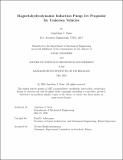Magnetohydrodynamic Induction Pump Jet Propuslor for Undersea Vehicles
Author(s)
Daus, Jonathan J.
DownloadThesis PDF (3.395Mb)
Advisor
Sclavounos, Paul D.
Terms of use
Metadata
Show full item recordAbstract
There has been a strong interest in Magnetohydrodynamic (MHD) technology for use in marine propulsion for over 60 years, but progress been limited due to the inability to create strong enough magnetic fields (> 5T). The Defense Advanced Research Projects Agency (DARPA), Defense Sciences Office (DSO), recently released a Broad Agency Announcement (BAA) for their Principles of Undersea Magnetohydrodynamic Pumps (PUMP) program, soliciting for the design and prototype development of an MHD propulsor for naval applications. This thesis investigates the design of an induction based MHD propulsor for use on submarines. The objective of this work was to optimize the propulsor design such that its electrical efficiency, ηE > ηD, where ηD is DARPA’s goal efficiency of 70%, while achieving the required thrust for tactical speeds (∼ 10 kts). This research modeled the propulsor using Actuator Disk Theory (ADT) and incorporates inflow boundary layer effects and hydrodynamic drag to develop a total propulsor efficiency. There was a significant investigation into the mitigation of the finite length effect that has traditionally led to low efficiencies (5%- 45%) in MHD liquid metal induction pumps. Analysis showed that the design of the current waveform was essential to achieving relevant efficiencies, where the Nuttall Window was selected as the optimal waveform for this application. Additionally, this work concluded that the propulsor efficiency is largely dependent upon the selection of the current carrier wavenumber k0 and wavenumber slip ε, which is defined as ε = (ω/V) −k₀, where ω is the angular frequency of the A/C current, and V is the fluid velocity inside the shroud of the propulsor. Results showed that, ηE ≥ ηD was achievable for practical magnetic field strengths (≤ 20T).
Date issued
2024-05Department
Massachusetts Institute of Technology. Department of Mechanical EngineeringPublisher
Massachusetts Institute of Technology